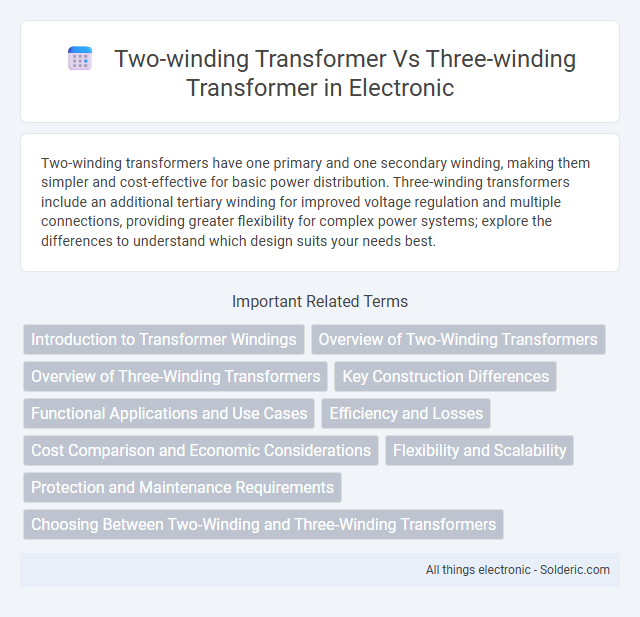Two-winding transformers have one primary and one secondary winding, making them simpler and cost-effective for basic power distribution. Three-winding transformers include an additional tertiary winding for improved voltage regulation and multiple connections, providing greater flexibility for complex power systems; explore the differences to understand which design suits your needs best.
Comparison Table
| Feature | Two-Winding Transformer | Three-Winding Transformer |
|---|---|---|
| Number of Windings | Primary and Secondary | Primary, Secondary, and Tertiary |
| Applications | Power transmission and distribution with two voltage levels | Complex power systems requiring three voltage levels or multiple feeds |
| Cost | Lower initial cost | Higher initial cost due to additional winding |
| Size and Weight | Smaller and lighter | Bulkier and heavier |
| Efficiency | Generally higher efficiency for simple loads | Efficiency may reduce slightly due to complexity |
| Flexibility | Limited to two voltage levels | Supports multiple voltage levels and complex network connections |
| Maintenance | Simpler maintenance | More complex maintenance |
| Common Usage | Residential and industrial power supply | Industrial plants, substations, and power grids |
Introduction to Transformer Windings
Transformer windings are critical components that enable voltage transformation through electromagnetic induction, with two-winding transformers featuring primary and secondary windings for basic voltage step-up or step-down functions. Three-winding transformers incorporate an additional tertiary winding, allowing increased flexibility for multiple voltage levels and improved load management in complex power systems. The tertiary winding supports auxiliary power distribution, harmonic suppression, and enhances system stability in multi-voltage network configurations.
Overview of Two-Winding Transformers
Two-winding transformers consist of a primary and a secondary winding, enabling efficient voltage conversion with simple construction and lower cost. They are widely used in power distribution systems for stepping voltage levels up or down to meet specific load requirements. Your choice between two-winding and more complex transformers depends on application needs, with two-winding transformers offering reliable performance for straightforward electrical isolation and voltage transformation.
Overview of Three-Winding Transformers
Three-winding transformers feature one primary winding and two secondary windings, enabling simultaneous voltage transformation between three different voltage levels. These transformers improve system flexibility by allowing power distribution to multiple loads or networks without additional transformers. Their compact design and ability to reduce installation costs make them ideal for complex power systems and industrial applications requiring multiple voltage outputs.
Key Construction Differences
Two-winding transformers have a primary and a secondary winding, each wrapped around a common magnetic core, enabling energy transfer between two circuits. Three-winding transformers incorporate a third winding, usually called the tertiary, allowing connection to an additional circuit for specialized applications such as voltage regulation or power distribution. The presence of the third winding requires a more complex core design and increased insulation between windings to prevent electrical faults and ensure efficient operation.
Functional Applications and Use Cases
Two-winding transformers are commonly used in simpler applications such as voltage step-up or step-down in power distribution systems, where primary and secondary windings suffice to transform voltage levels efficiently. Three-winding transformers find their functional applications in more complex systems requiring multiple voltage levels or connections, such as in power substations for interconnecting different voltage networks or feeding multiple loads from a common source. Your choice between the two depends on the specific use case requirements for flexibility, space, and cost, with three-winding transformers offering increased operational versatility in multi-voltage network scenarios.
Efficiency and Losses
Two-winding transformers generally exhibit higher efficiency and lower core and copper losses compared to three-winding transformers due to their simpler magnetic circuit and reduced complexity in winding arrangements. Three-winding transformers, while offering greater flexibility in voltage transformation and power distribution, tend to have increased losses because of the additional winding and magnetic leakage flux interactions. Optimizing your system for minimal energy loss requires careful consideration of the transformer type based on load demands and efficiency priorities.
Cost Comparison and Economic Considerations
Two-winding transformers generally have lower initial costs due to simpler design and reduced manufacturing complexity compared to three-winding transformers, which require more materials and intricate winding arrangements. Economically, two-winding transformers are preferred for applications with straightforward voltage transformation needs, offering cost savings in procurement and maintenance. However, three-winding transformers provide operational flexibility by enabling multiple voltage levels in a single unit, potentially reducing the need for additional transformers and associated infrastructure costs over the long term.
Flexibility and Scalability
Two-winding transformers offer simpler design and are ideal for basic step-up or step-down voltage applications but have limited flexibility when integrating multiple voltage levels. Three-winding transformers provide enhanced scalability by allowing simultaneous connection of three different voltage circuits, improving system flexibility for complex power distribution and reducing the need for multiple transformers. This scalability supports dynamic load variations and simplifies network expansion in industrial and utility grids.
Protection and Maintenance Requirements
Two-winding transformers generally require simpler protection systems, focusing on primary and secondary winding faults, which simplifies maintenance and reduces downtime. Three-winding transformers need more complex protection schemes to monitor interactions between all three windings, increasing the need for comprehensive testing and maintenance. Your choice impacts overall reliability and operational costs, as three-winding transformers demand more detailed inspection and fault diagnosis to ensure safe performance.
Choosing Between Two-Winding and Three-Winding Transformers
Selecting between two-winding and three-winding transformers depends on the application's voltage requirements and load distribution. Two-winding transformers are ideal for simpler systems with straightforward voltage conversion, offering cost efficiency and ease of maintenance. Three-winding transformers provide enhanced flexibility for complex networks by supporting multiple voltage levels and reducing the need for multiple transformers, improving space utilization and operational efficiency.
two-winding transformer vs three-winding transformer Infographic

 solderic.com
solderic.com